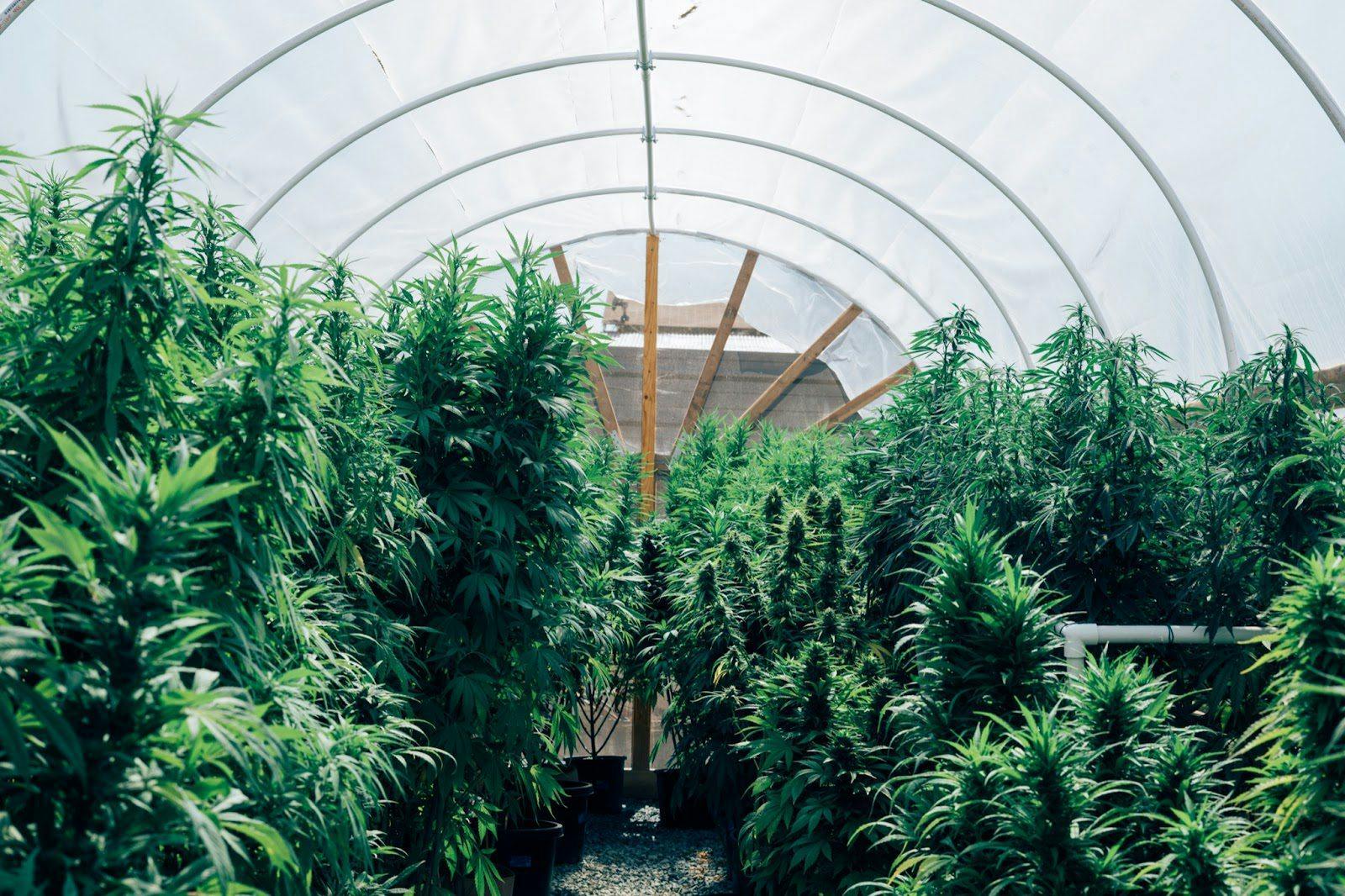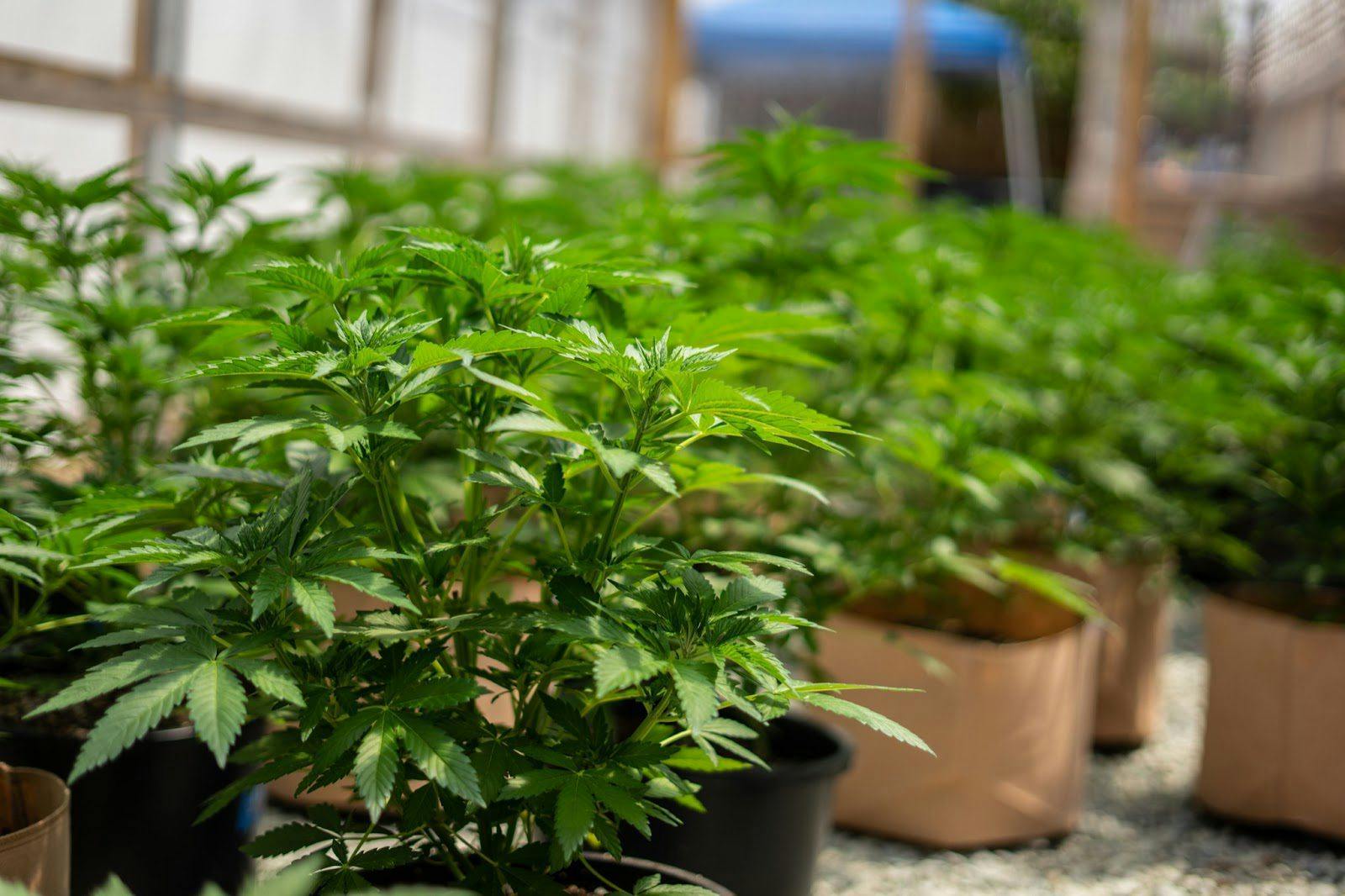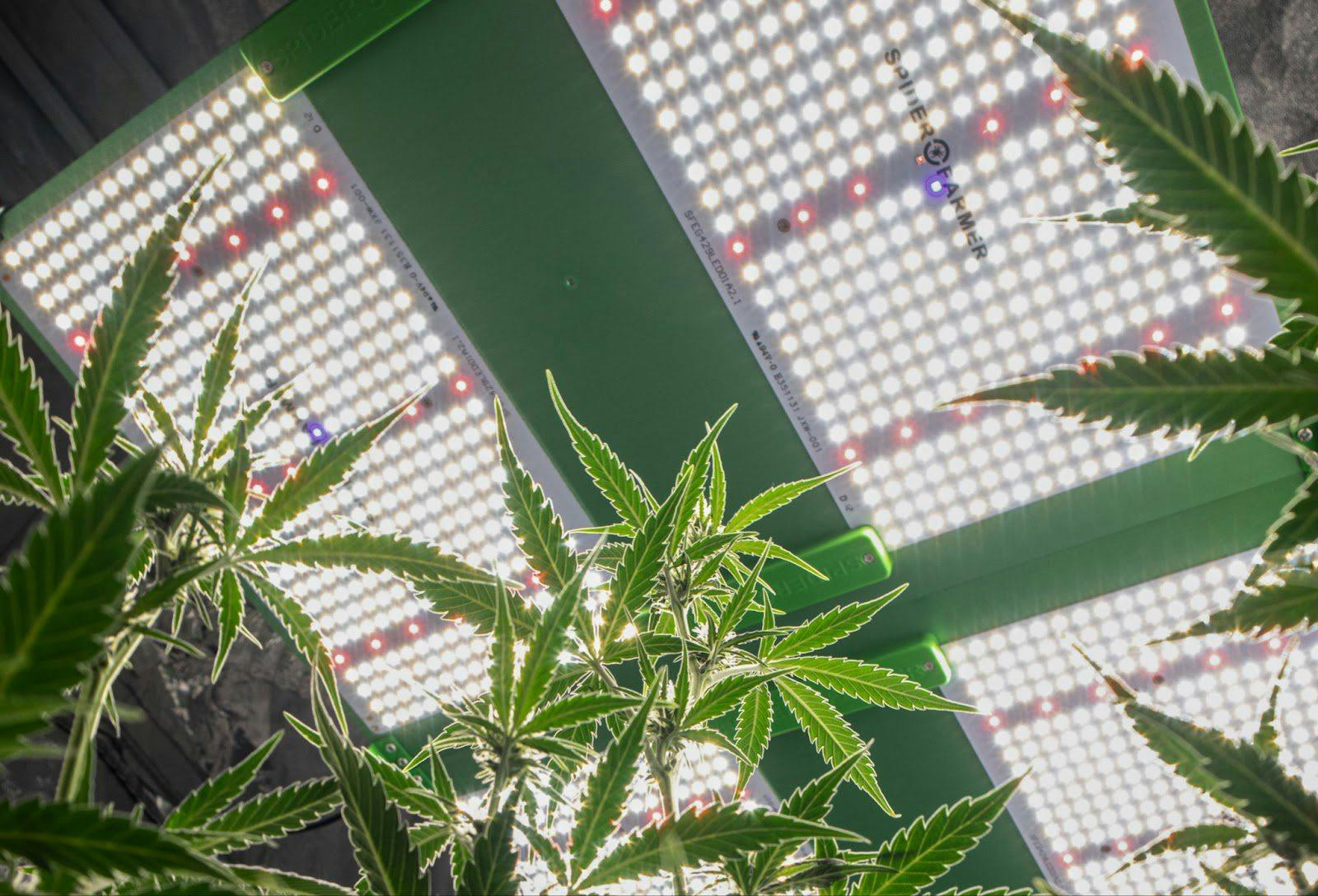How to Grow Marijuana in a Greenhouse

Article written by

Homegrown Cannabis Co.American Seed Bank and Cultivation Experts
Content reviewed by

Dr. Lewis JasseyMedical Director - Pediatric Medicine
Are you struggling to decide between indoor and outdoor cannabis cultivation? Consider learning how to grow marijuana in a greenhouse instead.
Greenhouses are sheltered structures covered by a partially transparent material. They protect plants from the elements while using natural light to feed and fatten buds. They’re simpler than grow rooms and offer greater control than open-air gardens. Essentially, they’re the best of both worlds.
Get Your Medical Card
Connect with a licensed physician online in minutes.
Benefits of Growing Cannabis in a Greenhouse
Here are eight compelling reasons to pick marijuana greenhouses over indoor and outdoor gardens.
1. Longer Growing Season
The growing season in North America is typically between mid-April and mid-October. There are no freezes over this period, and plants can safely stay outdoors.
If keeping a particularly long flowering strain, you might take pots indoors when temperatures drop. Alternatively, learn how to grow marijuana in a greenhouse and extend these six months to seven or even eight.
You can take seedlings to a greenhouse in mid-March, using artificial lighting and heaters to keep them cozy. Likewise, you may extend flowering to early November, even if the nighttime lows are under 60°F.
2. Year-Round Cultivation
Like a regular grow room, a greenhouse enables climate control through lamps, heaters, humidifiers, and fans. You can create a tropical weed paradise even if it’s dark, cold, and miserable outside.
Since the walls trap heat and humidity, year-round cultivation is cheaper in greenhouses than indoors.
3. Consistent Microclimate
Cannabis enjoys a narrow temperature range. Nights should be around 10°F colder and 10% less humid than days. When there’s a significant difference between minimums and maximums, plants get stressed and diseased.
A greenhouse setup can sustain higher average temperatures than an open-air environment. Hot air circulates and remains inside, and there are no sharp drops. It’s the same with humidity, as moisture doesn’t dissipate.
4. No Adverse Weather Risk
Besides keeping the environment steady, greenhouses shelter your garden from strong winds and rain.
You could achieve this effect by installing panels and a retractable roof in an outdoor setup. Still, you must stay near your cannabis to use them. Greenhouses offer hands-off protection around the clock.
5. Reduced Pest Risk
Greenhouse cannabis sits in a closed system, so crawly creatures can’t just show up to attack it. Pests can still enter when you’re opening and closing doors, but their access to your weed is considerably limited.
6. Higher Yields
The harvest potential relies on several factors: strain, seed genetics, climate conditions, and plant health. Since greenhouses ensure environmental stability and reduce pest and disease hazards, they promote high yields.
7. Energy Efficiency
Greenhouses can operate without devices during the summertime. If you use them to warm or cool the space, you get consistent conditions without having to keep them on 24/7. You use less electricity to maintain the optimal weed-growing environment.
8. Inexpensive
Growers don’t have to pay through the nose to set up a greenhouse. You can purchase it for little money or DIY it for added savings. If cultivating in summer and not automating, costs are only slightly higher than with an all-natural outdoor setting.

Download Our 7 Page Guide to Growing Cannabis
Building a Greenhouse
A greenhouse setup isn’t too expensive, but it’s cheaper to DIY it. This task isn’t too complex, and it doesn’t require special building skills.
Here are the steps to assemble a rudimentary greenhouse for cannabis plants and tips on upgrading it. We also cover pre-built options if you don’t feel like making one from scratch.
Choose the Right Spot
Location is key to getting good results from a greenhouse. Ideally, you’ll pick a flat spot with 10-12 hours of daily direct light exposure. It’s best to build facing the direction of the sunrise and away from tall trees or buildings.
Acquire Tools and Materials
The main structure of a small greenhouse consists of the following:
- 20 feet of PVC pipes for the skeleton
- 14 feet of PVC pipes to solidify the frame
- Polyethylene plastic or glass sheeting
- Six two-foot rebars for the foundation
- Staple gun and duct tape to secure the sheeting
- Wooden boards for the floor and raised plant bed
PVC is the perfect material for the frame, as it’s sturdy and inexpensive.
Regarding the walls, plastic is cheaper and retains more heat. Safety glass is easier to wipe clean and enables better light penetration. We suggest plastic for first-timers, as it’s easier to manipulate into shape. In either case, choose semi-diffuse instead of transparent materials.
Build the Base
Use a mallet to pound the rebars into the ground. Place them in each corner and the middle of the side walls, about three feet from each other.
Install wooden boards inside these edges, adding a floor to your structure.
Build the Frame
For a polytunnel model, you use PVC pipes whole. If looking to build something more house-like, cut them into straight pieces instead of bending them. In the latter case, plan the dimensions based on the size of your glass panels.
Take one end of the pipe and place it over a rebar. Bend it into an arch and secure the other end onto the opposite rebar. Repeat for all pipes.
To add to the stability, connect shorter PVC pipes to the topmost point of the arches. Use zip ties or generous amounts of duct tape to affix them.
Don’t forget to leave room for a doorway on one of the shorter walls.
Attach the Sheeting
Apply duct tape on the outer layers of PVC pipes to hold the sheeting in place. Then, drape the plastic over the structure. Secure the sides by pressing the sheet against the duct tape. Stretch it enough to tighten and staple the bottom onto the baseboards.
If installing glass walls, place the panels between your pipes and employ a silicone sealant to secure them.
Create vents at this time by cutting the sheeting. You might remove a foot-wide strip on the side wall or create several small holes in the roof.
Introduce Additional Elements
You have your basic marijuana greenhouse and can now fit it with accessories for greater cultivation success. Excellent options include:
- Climate control meters: Hygrometers and thermometers help keep the humidity and temperature in check.
- Extra grow lights: HPS or LED lamps hung above the canopy can supplement the sunlight on overcast days.
- Light deprivation coverings: These panels let you manipulate the light cycle even though you’re growing outdoors. They come in the form of blackout curtains and roof covers.
- Additional ventilation: Exhaust fans and ventilators keep the air circulating throughout the space and reduce mold risk.

Buying a Greenhouse
What if DIY-ing isn’t your jam? You can buy a pre-built model. These are the top options for greenhouse growers available in stores:
- Attached greenhouses (lean-to greenhouses): This option leans on the side of your house. It’s more compact than the alternatives and ideal for small-scale cultivators.
- Freestanding greenhouses: Usually in the shape of an apex. They stand on the lawn or any other flat surface. The frame is wood or aluminum, casting shade on the plants.
- Polytunnels: Most common in commercial farming, with curved aluminum frames covered by polythene sheets. This model is the cheapest but also warms the most.
It’s a good idea to upgrade any of these options with devices.
How to Grow Weed in a Greenhouse
Growing cannabis requires keeping environmental variables in check to maintain plant health, and greenhouse cultivation is no exception. Here are the steps to getting sticky buds from this setup.
Step 1: Pick a Suitable Strain
As a rule, choose types of cannabis that don’t mind high humidity levels, as the air can get moist in a greenhouse. Also, it should be able to fit within the available space at its maximum height.
Another factor in your decision is whether you’ll use supplemental lights.
Non-photoperiod strains are optimal if relying only on natural sunlight. Autoflowers don’t require a set schedule to bloom, so you can grow them anytime. They’re smaller and fit in constrained spaces, too.
Photoperiod strains are tricky if relying exclusively on the sun. The seasons move plants from vegging to flowering, so cultivation is only available from April to October. If using supplemental lighting, the only concern is trimming into a desirable shape.
Tip: Pick beginner-friendly cultivars for your first greenhouse grow op. That way, you have time to master the specifics without compromising harvests.
Step 2: Germinate Seeds
Germination is the first step in growing marijuana. Keep cannabis seeds between moist paper towels until they produce taproots. Then, sow them into potting soil and keep them under fluorescent lamps in an 18/6 light schedule indoors until the seedling has two nodes.
Step 3: Maintain the Environment
When you take seedlings to a greenhouse, it’s your primary task to keep the climate conditions optimal for vegetative development. Environmental preferences are strain-dependent, but most cultivars enjoy humidity levels of 55% and around 80°F during veg.
If it’s still cold in early spring, employ a heating device to keep plants cozy. You can also use lamps on overcast days to ensure 18 hours of light exposure.
Step 4: Provide Plant Care
Plants in the vegetative stage enjoy high doses of nitrogen each week and watering every other day. You should also regularly inspect them for pests and health issues.
Step 4: Manage Plant Stretching
Cannabis plants in greenhouses stretch tall while reaching for the sun. Topping and training techniques let you manage their height and promote optimal development. Skip them with autoflowers, as their growing cycle is too short to accommodate stress.
If not training, prune weekly to remove excess foliage and enable light penetration.
Step 5: Flip to Flowering
If keeping photoperiods during the regular growing season, the days get short enough for flowering in early August. Non-photoperiods automatically bloom after 5-6 weeks of vegging.
Stop training and ensure the plants receive 12 hours of light each day. Transition to bloom nutrients.
What if you grow photoperiods outside the usual change of seasons? You can still trigger the flowering stage by using light deprivation blinds to shorten the daytime duration artificially.
Step 7: Extend the Growing Season (Optional)
If your plants aren’t perfectly ripe by mid-October, why miss out on the optimal harvest window?
You can leave them in bloom for several more weeks in a greenhouse. Use heaters to maintain temperatures and lamps for further bud fattening. Harvest when the trichomes are opaque and pistils curl inward.
The Bottom Line
Greenhouse cultivation sets you up with massive yields of sun-grown buds. It shelters plants from pests and adverse weather conditions, lowers your utility bills, and extends the growing season. What’s not to love?
Whether buying or DIY-ing, the price isn’t exorbitant. This setup has a low barrier to entry and offers a gratifying cultivation experience. It’s perfect for folks who lack indoor space or enjoy outdoor growing but prefer having control over the outcome.
Get Your Medical Card
Connect with a licensed physician online in minutes.
Frequently Asked Questions
Does marijuana grow well in greenhouses?
Marijuana grows well in a greenhouse. A cannabis greenhouse offers a combination of protection and controlled sunlight. It’s the ideal environment for seedlings, vegging, and flowering plants. The sun helps them stretch and get sticky while staying safe from anything that could cause stress or disease.
What type of greenhouse is best for marijuana?
Many greenhouses support prolific cannabis production, but newbies fare best with the attached models. They’re heat-efficient and half the size of commercial ones, requiring less space and electricity to get you started.
Can you grow marijuana in a greenhouse in the wintertime?
Greenhouse cannabis growers can cultivate over the fall and winter. To prolong the growing season, employ supplemental lights during the vegetative stage and cloudy days in flowering. Heaters and humidifiers can create optimal conditions for marijuana plants despite the biting cold.
